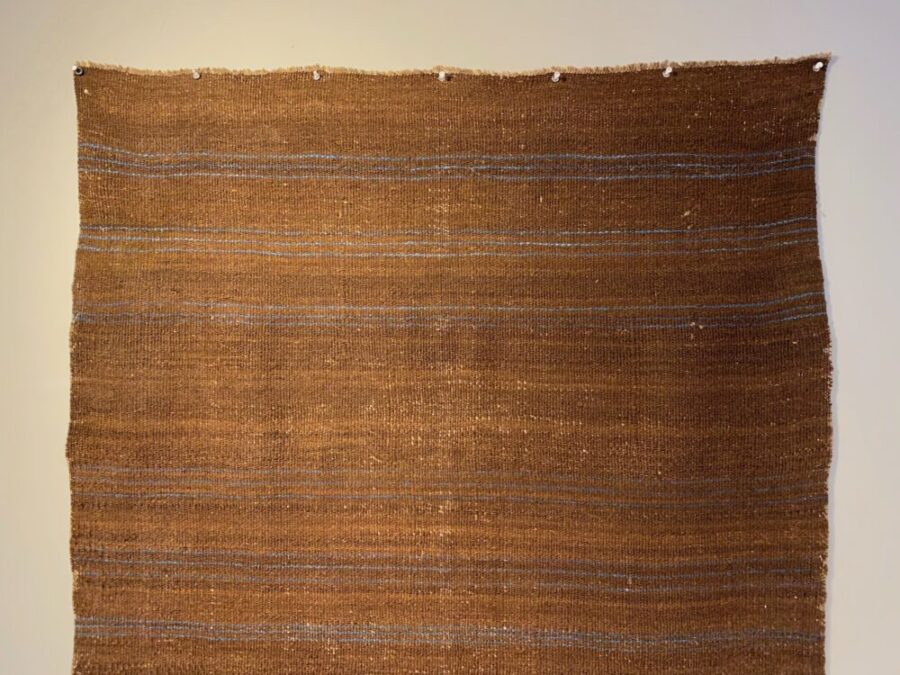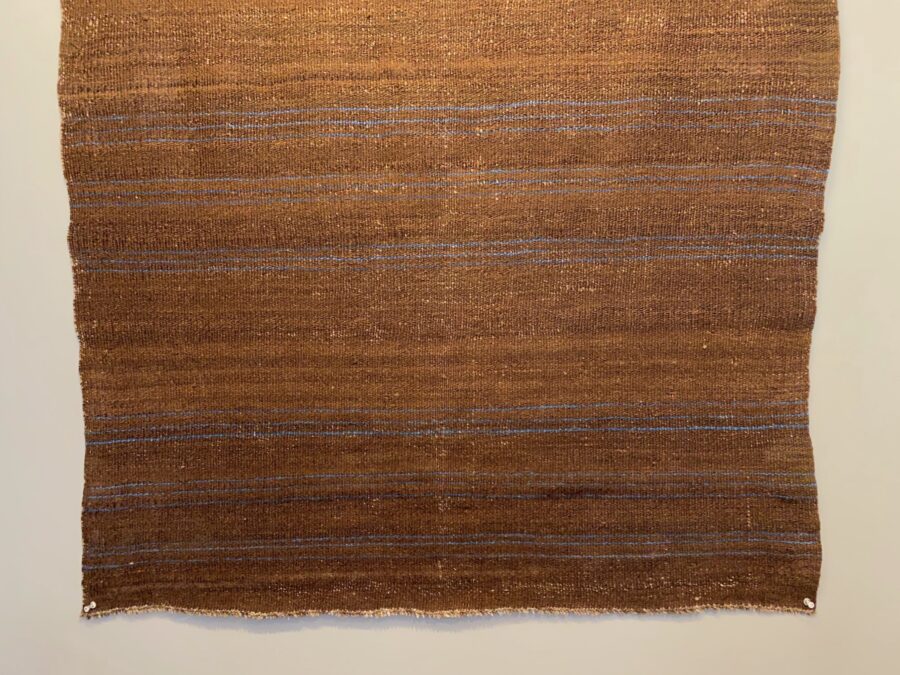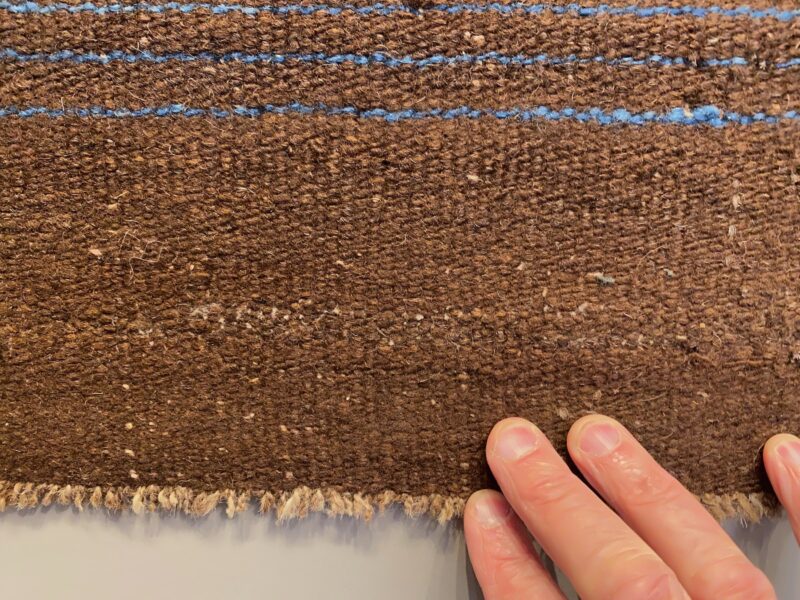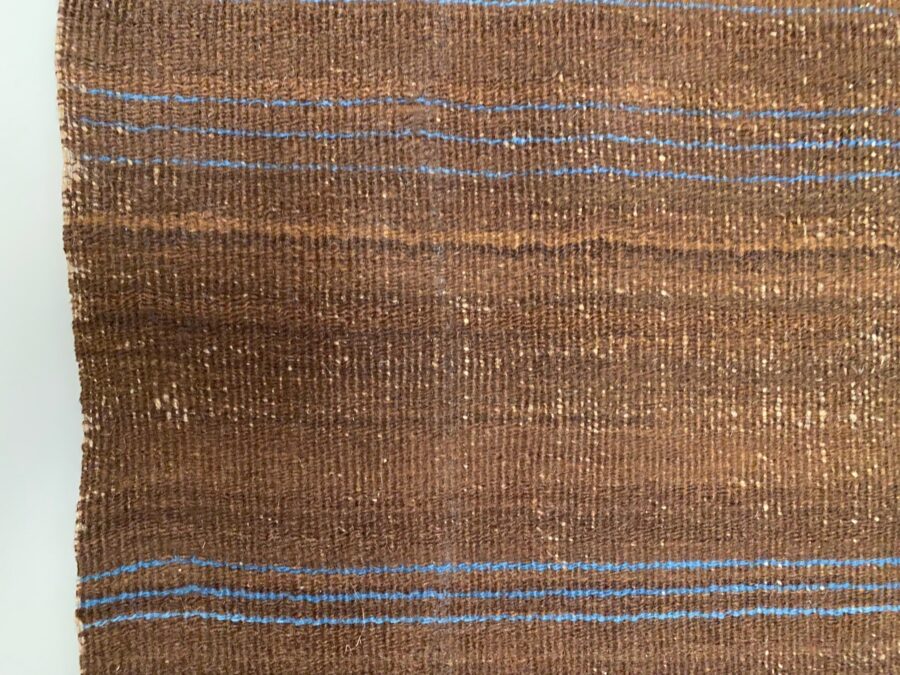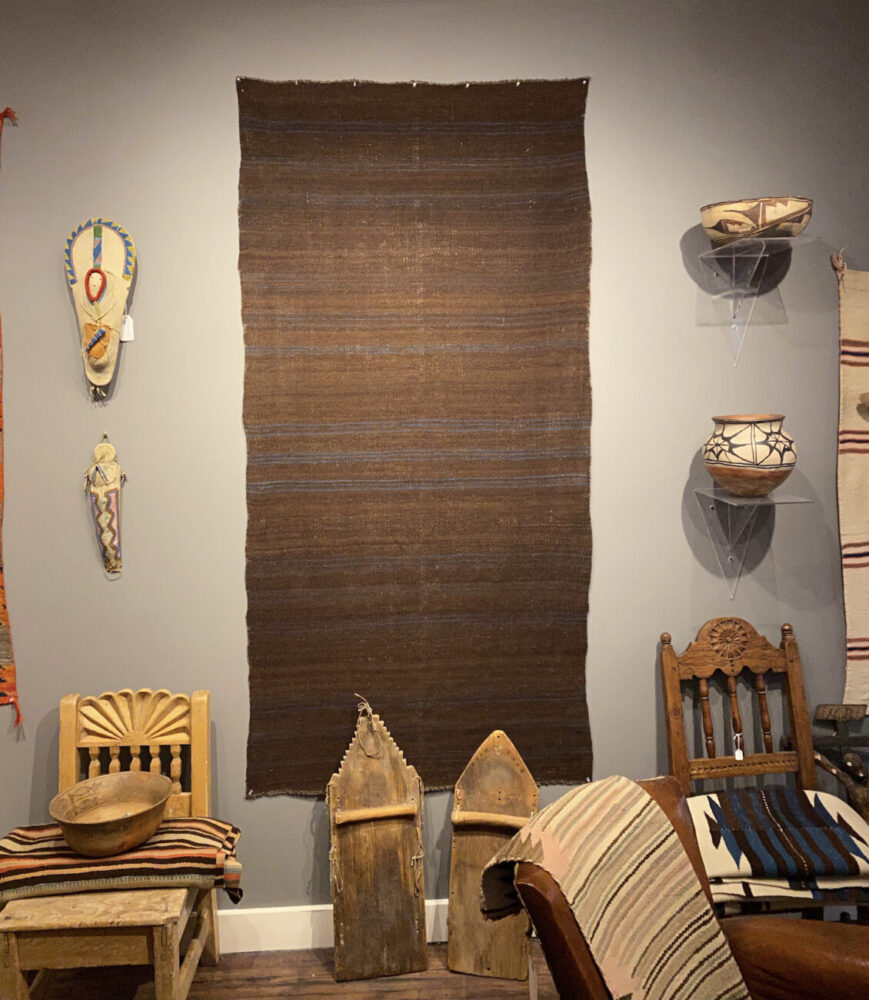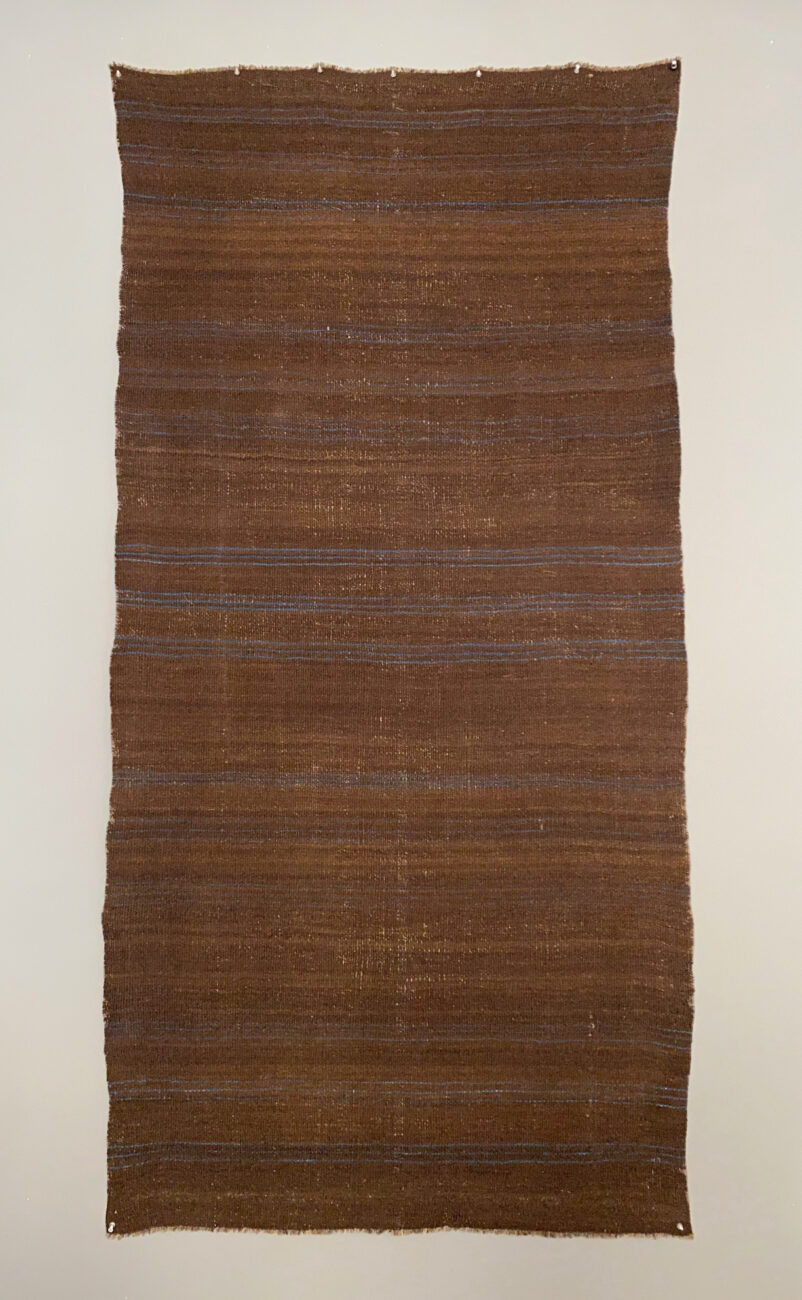
An Early New Mexican Rio Grande Weaving, Possibly 18th Century
- by Jamie Compton
- in Gallery News My Thoughts on Native Art New Gallery Item
- posted November 27, 2021
Clues Defining this Weaving as a Rio Grande Blanket
A rare and unusual blanket came into my gallery. The blanket was brought to me as a pueblo weaving. I discovered with close inspection that it was a New Mexican Rio Grande blanket woven by Spanish Colonialists. The weaving is ancient in look and feel. The end warps gave me my first clue: 2 ply warps instead of 1 ply. Navajo and Pueblo blankets are almost always 1 ply, and Rio Grande blankets almost always 2 ply. There also were no side selvages and the warps were cut at the ends and made into knots, two features typical for a Rio. Lastly, I saw no sectional lines (lazy lines) as commonly found on Navajo and some Pueblo blankets. Add up all these elements and it was clearly a Rio Grande blanket. The photo below shows 2 sets of 3 band systems, with each band system comprised of 3 thin lines of indig0.
A Rare Find
Brown wool weft was all I saw when I first held the blanket. The whole blanket is made with a warm, brown weft in striations of lighter and then darker variations. Looking closer, I saw indigo blue strategically place within the brown field. Finding these finite bands of indigo was like finding gold; precious, rare and bright by nature. The indigo was such a light color, much lighter than typically found on these blankets. I was very excited and new I had found an early treasure.
There is no way to determine the age of a blanket outside of having the wool carbon dated. Carbon dating only works if the wool is at least from the 1600s, since after this the window of accuracy gets lost up till about 1950. That window is too large to test a blanket like this, unless the wool came from before the later 1600s.
Design elements, weaving techniques, type of material, coloring, etc. can all be used to consider dating. There is also the “feel” of a blanket, which takes in all these elements together as a way to see. In essence, it’s really using one’s gut, and my gut has been getting training since the day I was born if not even before.
Why I Feel this is an 18th Blanket
The blanket is woven with 5 sets of bands, with each set being three groups of three lines each. The grouping in the center has the indigo lines at 2 to 3 wefts wide whereas the other indigo lines away from the center are from 1 to 2 wefts of indigo. As a result, the center system of bands stands out more than all the others, but only in a subtle way. The photo below shows these wider bands of indigo. If you look closely at this photo, you can see at the very end of the top indigo band to the far left the most outer warps which are two laying side by side whereas the next inner warp is only a single one which continues on into the blanket. One can also see here that there is no side selvage as is typically found on a Navajo blanket.
The photo above shows the exposed, cut warps at one end. The warps have been tied off with a simple knot adjacent to the final weft of brown wool.
Below are the reasons why I feel this blanket is likely 18th century or earlier. My limits here are many, but putting the ideas forward is the best way to test the ideas. These suppositions are meant to generate reactions, and I welcome any thoughts on the matter.
- The narrow and long proportions suggest an earlier date. The blanket measures 78” long by 38.5” wide. These narrow and longer blankets are characteristic not just of Spanish Colonial weavings, but also Navajo and especially early ones from the first half of the 19th century. The blanket is also smaller than most every Rio Grande blankets I have seen outside of the obvious child’s example. This size could be an anomaly, or it could have been the more common size for a 17th or 18th century blanket when I imagine the people were smaller.
- The 5/6 warps per inch suggests an earlier date. The spacing of warps on earlier blankets are less since the reeds on the loom are made of wood. Later, the reeds are made of steel allowing for a tighter spacing.
- This blanket was woven on a particularly narrow loom, roughly 20” wide. It is rare to see such a small loom. Most if not all 19th century blankets are larger than this one. As far as my research goes, this is the narrowest blanket I have come across. This blanket was woven with the warps doubled up, so half of the blanket was woven under the top half. The grouped warps in the center of the blanket are a testament to this technique, showing the point of transition in how the blanket was woven. As best as I can tell, the central warp consists of two warps side by side. All the other warps are single two-ply until one gets to the edge, which is just like the center with two parallel warps adjacent to each other. The photo below is taken in the very center of the blanket. My finger is pointing to what appears to be a double set of warps in the exact center of the blanket. This is the point where the warps turned to become two layers of warps so that the entire blanket could be woven at the same time instead of two halves. Also notice that the indigo bands here are only 1 – 2 wefts or yarn, as these thin bands are not a the center but are placed further out.
- The brown weft was woven directly into the blanket from a bundle of wool and was not processed, such as carded, with other wool to become a more consistent color. This earlier technique of less processing creates the abrash, or striations of varied colors of brown going horizontally, across the blanket. The photo below shows a good example of the varying striations of brown weft.
- Both the minimal use of indigo blue as well as the lighter color suggests an earlier date. Early on, indigo was a very rare commodity. It was rarely used in what is now Mexico during this early period (in fine Saltillo blankets yes, but not in frazadas, or early common blankets). The lighter color also suggests an earlier date as the saturation of the indigo is less, showing the results of a highly conserving period. This conserving technique is consistent with an earlier pattern of indigo use.
- The brown weft is not packed tight into the warps. In addition, the individual wefts are not twisted very tight, but barely have a twist at all. The earliest blankets I have in my collection and as well seen elsewhere are more loosely packed, resulting in the more frequent showing of warps. While this makes for a lighter blanket overall, it also potentially makes for a warmer blanket. Less packing of the wefts and less spin of the wefts contributes to an airier blanket. Just like down has a high thermal level of warmth, so does this type of wool structure.
- The brown weft is highly felted in that it is hard to pull apart. The wefts have migrated into each other. This is a product of age and use.
- The simple design suggests an early date. The earliest blankets have the simplest design limited to banding. This blanket has a highly pursed down look as if it’s part of the earlier development of the banded blanket.
- Lastly, the “feel” of the blanket speaks clearly to me that it’s old. That feeling is an amalgamation of all sorts of ideas and is something that comes more from my gut more than from my mind.
How old could this blanket be? There is very little, if any, documentation of 17th or 18th century blankets. There are some simple written descriptions, but no photos, drawings or paintings of these early blankets. A small handful are considered to be from the 18th c. by Joe Ben Wheat in the book Blanket Weaving in the Southwest. Plate 30 on page 179 shows a Navajo blue borders manta dating from 1750 – 1850 as an example.
There is a similar blanket pictured in the book Rio Grande Textiles by Nora Fisher, Museum of New Mexico Press, Santa Fe. Plate 25 on page 56 shows an all-brown blanket with finer and lighter colored indigo blue bands. This blanket measures 85” long and 47” wide and is dated to ca. 1860. It belongs to the School of American Research, Santa Fe, T.453. The structuring of the indigo bands is similar but different and there is a center line of indigo in this example. The bands of indigo appear wider, and their spacing and frequency is not as tight as my example. It would be interesting to see these two blankets next to each other for comparison. On the SAR blanket there are very few warps exposed. The brown weft also appears more uniform, but this could be a result of the photography.
It’s a reasonable deduction that this blanket has unique characteristics that could place it to the 18th century or earlier. This blanket is currently on display at my gallery and I encourage you to drop by if your’e in Santa Fe for a close up view. Any comments or suggestions would also be appreciated.

